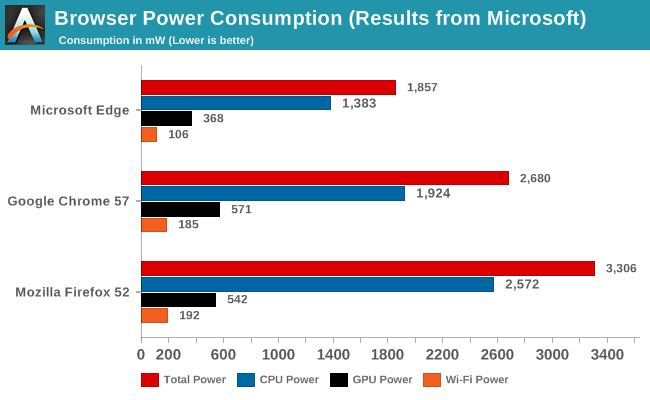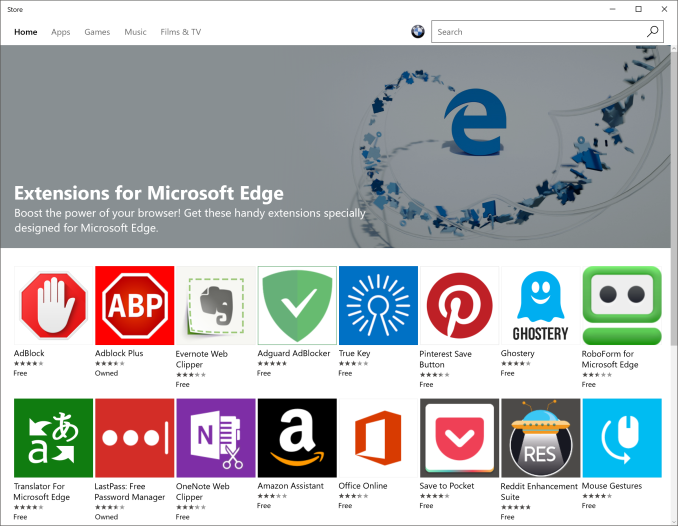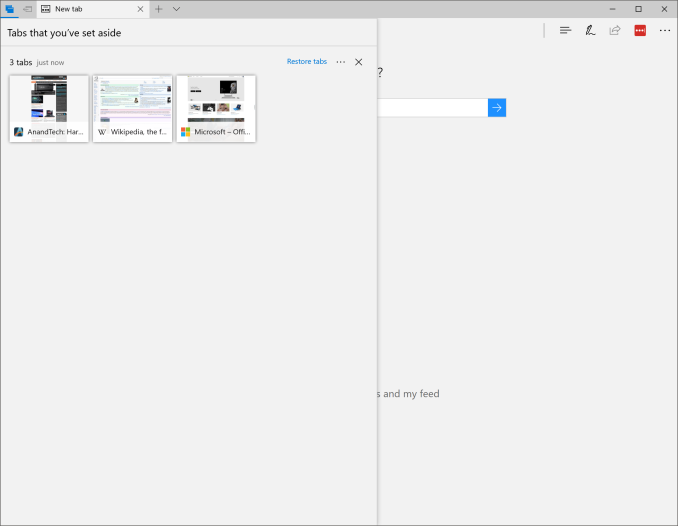The Windows 10 Creators Update Arrives
by Brett Howse on April 25, 2017 8:00 AM EST- Posted in
- Software
- Operating Systems
- Windows
- Microsoft
- Windows 10
Edge Improvements
When Edge launched, Microsoft seemed to have a couple of goals. First, they would dramatically improve security over Internet Explorer, and second, they would drastically improve performance, and keep up the performance improvements over time.
Edge adoption has been very low though. When it first launched, it was lacking a lot of basic features, with important additions like extension support only coming with the Anniversary Update. Extensions was a arguably the biggest single feature missing, and it has been very nice to have a much more capable browser because of this addition, but with low usage share of Edge, coupled with extensions having to be added to the Windows store by the developer, has resulted in there still only being a handful of extensions in the store. At my count, there are 27 extensions, but that might vary based on region. It’s a step in the right direction, and this one change has made Edge much more useful than before.
Edge excels in some areas. Its support for high resolution displays, and its text rendering, continues to be one of its biggest strengths. Performance on scripting is generally quite solid, although it still struggles with pages like Twitter if they are left open for a long time. Microsoft has posted quite a few blog posts about how they have optimized things like scrolling performance with touch, mouse, or keyboards, as well as battery life improvements. Edge has come a long way, and they continue to improve it with every release.
Edge didn’t get anything as big as extensions with this update, but it still got quite a few improvements. The most noticeable is the ability to expand tabs to show the entire page in a mini-window at the top of the screen. This is very similar to how Internet Explorer worked in its touch mode in Windows 8, and can be a useful feature if you are one of those people who keep losing tabs. Also, you can “set tabs aside” which lets you collapse open tabs to the left, where there’s a box to let you open them again. It’s an interesting idea, but in practice it seems to need quite a bit of work. You can’t put individual tabs aside – it’s all or nothing – instantly making it less useful. Also, if you restore a tab from one you’ve put away, and then you close that tab, it’s gone. There’s no way to keep a set of tabs set aside permanently which would be a nice take on favorites. Once tabs are put aside, you can add them to favorites, or share them. The share idea is quite nice, and makes it very simple to share multiple sites with someone in one email. Still, it would be nice to see this fleshed out a bit more.
Microsoft has been touting Edge’s battery life performance for some time now, and they continue to improve Edge to make it more efficient. Their testing methodology is all open-source, which certainly helps with its credibility. According to Microsoft’s measurements, during their tests on identical Surface Book laptops, and averaged over sixteen iterations per browser, Edge used 31% less power than Chrome 57, and 44% less power than Firefox 52. These are significant amounts, and in a power basis, Edge is using under 2 Watts for the same activity that Chrome is using over 2.5 Watts, and Firefox is using around 3.25 Watts. Battery capacity is always going to a be a limit on notebooks, so any efficiency gains are important.

Edge has also gained support for ePub digital books, and WebRTC 1.0 is now on out of the box. There are other small changes like being able to run an .exe file directly rather than having to save it first, and there are some small improvements to PDFs in Edge, and Web Notes.
Also, in the never-ending struggle to remove Flash from the web, Microsoft has made the decision to make Flash click to run in Edge. That means that any page that wants to run Flash won’t be able to, but you can click an icon to enable it. It’s not very obvious, with the icon resembling a puzzle piece, but there is a graphic which shows you what to do the first time it pops up. The results of this change have been mixed, but with browsers moving to disable Flash by default, hopefully that will pressure sites away from using it.
 This puzzle icon means Flash can be enabled for the page
This puzzle icon means Flash can be enabled for the page
Overall, Edge has made some improvements, but nothing huge like in the last update. It needs some more basic functionality added though, such as the ability to view a page source (the debugger tools are overly complex for simple tasks) and it is still far easier to do a lot of tasks in Chrome, which shouldn’t be the case this far into Edge’s existence.












69 Comments
View All Comments
Ubercake - Tuesday, April 25, 2017 - link
When it comes to hardware of any kind coming out of Microsoft, count on Microsoft to stop producing and supporting (or in other words "giving up") on it within a couple of years. This Surface Studio is a fantastic idea. The Microsoft Band was a great idea/product. Now no longer supported/produced. The Surface RT was a great idea that wasn't supported after its 3rd year. Mainstream phone apps are still not there. Zune music player (sort of competing with iPod) was gone soon after it was started.The universal windows platform or whatever it won't be called because the hardware just won't be their to support the idea in a few years. Nothing portable device outside of the Surface Pro (all 10 of you Surface Pro users know what I'm talking about!) will be around using the Windows OS in a few years. Why is Microsoft focusing at all on a universal platform that isn't Android- or iOS-based when you know no Microsoft hardware is supported for more than a couple of years? So they can quit it in a couple of years like everything else?
xthetenth - Tuesday, April 25, 2017 - link
The reason the Surface 3 is gone without a successor is because the niche for a lower cost 2 in 1 is an ecosystem now, not a single product.Flunk - Tuesday, April 25, 2017 - link
Intel also pulled the plug on the line of Atom chips the Surface 3 used, leaving Microsoft high and dry. It's possible they'll come up with a new non-pro Surface that uses ARM chips, but that didn't sell all the great the first time.gerz1219 - Tuesday, April 25, 2017 - link
They seem to have a foothold with the Surface Pro, so I wouldn't expect them to kill that any time soon. The problem with Microsoft's hardware ventures is that many of them simply haven't sold very well. They kind of had to give up on the Zune when they had warehouses full of unsold units and it was clear that nobody wanted an alternative to the iPod. Same for Surface RT and the Windows phones.I think any Microsoft device that kind of overlaps with traditional desktops will be well supported in the future. It's their attempts to branch out into mobile that have routinely failed and been abandoned.
Holliday75 - Tuesday, April 25, 2017 - link
I have a Surface Pro. Who are the other 9 users? We should start a club!SaolDan - Tuesday, April 25, 2017 - link
SP4 FTW.Instyle - Thursday, April 27, 2017 - link
The Surface Studio is currently available so I have no idea what you're talking about there. The Surface Pro and Xbox lines have sold in the millions, have plenty of active users and are currently supported. The Zune was supported for quite a long time as well. I think you need to go do some research. The main failed products were Windows Mobile, Surface RT and Microsoft Band.DanNeely - Tuesday, April 25, 2017 - link
"Hopefully we’ll have a chance to dig into this a bit more in the future."Some things in game mode I'd be interested in seeing tested (and might try myself in a few weeks or month when I install the update) are if it helps distributed computing play any nicer with not just games but foreground apps in general. I run several BOINC projects with my spare CPU/GPU cycles. For the most part it just works on the desktop and with simpler games. Games that are GPU heavy or use multiple heavy threads are a problem though because the OS doesn't give enough GPU to keep frame rates up and effectively only lets the game have a single CPU core. Boinc's mitigation options are rather limited; basically I can set it so that when certain apps are running (by executable path) Boinc entirely stops CPU and/or GPU apps. It's all or nothing though (meaning I can't let it leave 4 cores free for my game and continue to do science on the other 4).
More recently I've ran into occasional problems with HTML5 video playback while a GPU apps are running. Years ago I had similar problems with the general desktop and some GPU apps, but that was a much more consistent case. This is far more intermittent and I haven't been able to nail down any sort of pattern yet. May try gaming my browser to see what happens.
dgingeri - Tuesday, April 25, 2017 - link
Why am I so much less enthused about this update than I was about the last big one? It just doesn't seem to have anything I'm interested in.kwall8 - Tuesday, April 25, 2017 - link
The best addition is an address bar in regedit. Only took them 20 years :D